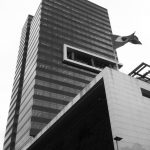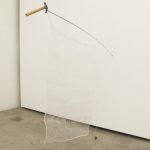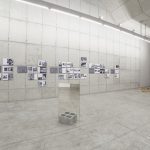TAIPA – TAPUME*
Curated by Tomás Toledo
Artists: Alexandre Brandão, Ana Mazzei, Beto Shwafaty, Baptistelli Bruno, Fábio Tremonte, Francesco Di Tillo, Héctor Zamora, Jaime Lauriano, Lais Myrrha, Pablo Accinelli, Sandra Gamarra and Sandra Nakamura.
The group exhibition Taipa-Tapume intends to use the history of Galeria Leme’s building – designed by Paulo Mendes da Rocha which was built, demolished and then rebuilt in another site – as a motto to investigate the process of urban development of the city of São Paulo, which is marked by cycles of construction, demolition and reconstruction, and the way the city handles its memory.
Between the 19th and the 20th century, São Paulo ceased to be a town with colonial features, made of mud, and of lesser importance in the national economic scene, to become a rich coffee-producing city and then an industrial, commercial and financial hub. These historical and urban moments were overlaid by urban development and shaped the city today.
As pointed out by the historian Benedito Lima de Toledo, in the book “São Paulo – três cidades em um século” (São Paulo – three cities in a century), “the city of São Paulo is a palimpsest – a huge parchment whose deed is shaved from time to time to get a new one (…).”
To articulate these propositions, I take the example of Pátio do Colégio, an archaeological site where the first edifice in the city of São Paulo was built in 1554, first in wattle and daub and then rammed earth. This building housed a Jesuit college and a church. With the expulsion of the Jesuits from Brazil in 1759, the site began to be used by the government as the seat of the provincial government of São Paulo until 1908. In this period the building that housed the school was demolished to make room for a neoclassical palace and the church suffered a landslide. In 1954, because of the celebrations of the fourth centenary of the city these buildings were completely demolished for the construction of a replica, made of reinforced concrete, replicating what they previously thought to be the original building of the college and the church.
This dynamic land occupation reveals the way in which São Paulo dealt and deals with its past and how it builds its historical narratives, showing the forces of power that shape the urban and social fabric of the city.
Given this historical period and this critical perspective, the exhibition is divided into four clusters of discussion: gallery Leme’s building, processes of construction and deconstruction, urban and architectural development of São Paulo and finally, land speculation and construction techniques.
In the first group, the work “Untitled” by Jaime Lauriano – a double mirror sandwiched between two concrete blocks – reflects the viewer, inserting him into the virtual image that the mirrors produce from the gallery itself. Thus, the mirrors modify the apprehension of space, putting in question the relationship between the subject and architecture. Still following this investigation, the painting “Untitled” by Bruno Baptistelli presents a composition generated by architectural structural elements, creating an image that proposes a new spatial field, but in this case does not give the mirror image, but by a opaque surface.
The work “Algunos usos prácticos para el arte en desuso”, from Sandra Gamarra, “narrativas cotidianas_Brasil01”, from Bruno Baptistelli and “Something without thickness”, from Sandra Nakamura, evoke the memory of the first building of the gallery, which was demolished, along with the whole urban block, to allow for the construction of a building which houses the headquarters of a construction company. Appropriating the physical aspects of the old building, Gamarra reproduces the concrete module used in the first building, which is
slightly larger compared to the one on the current building. Baptistelli uses photographic language to reproduce the building of the construction company, presenting it in a typical framework of modernist photography, giving the scene a false sense of historical value. Nakamura also uses the slight difference in size between the two buildings as a motto for conducting a site-specific intervention. Using a transparent varnish, she marks the gallery’s sidewalk revealing the size of the previous building, highlighting similarities and differences between the two buildings.
The second and third core, develop dialectically in order to articulate the processes of construction and deconstruction of urban fabrics – produced by continuous layers of the past, superimposed by the actions of the present – with the urban and architectural development of the city of São Paulo, marked by an indifference with the past and the aggressiveness of the housing market.
“Breve cronografia dos Desmanches”, from Lais Myrrha, originally designed as a book and presented here in a wall version, is a compendium of images that show various categories of demolition, ruins, landslides and situations of abandonment. Each image is accompanied by an entry – sometimes in a fictional tone, sometimes documentary – and evoke the failure of ideological and political projects, the inability to preserve the physical traces of the past and the possibility of rewriting historical narratives.
Continuing this investigation, “Momentum # 3” and “Momentum # 4” by Francesco Di Tillo – are photomontages that overlap postcards with scenes of post-war Europe with images of demolitions from regions of São Paulo, articulated in two layers of image, two temporal moments and two categories of ruin.
Developed initially in book form, “The life of the centers,” by Beto Shwafaty, is a photographic and documentary project that features three distinct moments of São Paulo with archival images and texts composed by memories and historical facts. The growth of the city is narrated from the displacement of the financial and commercial center from the central region and to Paulista Avenue e Berrini.
“Ghost bricks”, by Ana Mazzei, is a grouping of pieces of wood covered with layers of joss paper, a gold Chinese paper used in ceremonies to evoke the deceased ancestors. The symbolism of joss paper added to the configuration of the parts, which are arranged on the floor in order to emulate the aerial view of an urban fabric, suggests thinking about the layers, both constructive as historical, that make up a city.
Sandra Gamarra appropriates the fable “The Three Little Pigs” to produce an illustrated book which adapts the original narrative to the context of São Paulo. The house of every one of the pigs symbolically represents three stages of social and urban development of the city, connecting fictional narrative to the historical narrative.
In a site-specifc sound installation, Bruno Baptistelli appropriates the audio of a part of a song, “Da ponte pra cá” (From the bridge to here), from the group Racionais MC’s, which is triggered by the passage of the public through the walkway that connects the two blocks of Galeria Leme. The work establishes a metaphorical relationship between the two spaces of the building with the geographical positioning of Butantã, where the gallery is located. A walkway separates the offices from the storage, whereas the bridges over the Pinheiros River separates the expanded center from the peripheral areas of the city. The content of the song points to the geographic and social divisions of São Paulo.
In the works “Brick 9 holes” and “Paulista, from the Circumference Series”, Héctor Zamora uses typical building materials from Brazilian construction techniques, which somehow resist the constant technological advances in the field of construction. In the first case, a composition of brick with cut corners; in the second case a circle with typical tiles from São Paulo.
“Adobe”, by Alexandre Brandão, is a set of pieces of unfired clay, molded into shapes of soap arranged on a wooden table. The format of the object approaches the appearance of bricks, some are presented intact, other corroded by water. This presentation gives the work an archaeological aspect and can be also read as remnants of a past washed by historical processes.
These three works, here presented in the architecture of reinforced concrete Paulo Mendes da Rocha, operate as a sign of the contradictions of São Paulo, a city in constant clash between his past and a present marked by a failed development project.
The fourth core, facing questioning of real estate speculation, proposes a contrast between the imagery created by property launches with the social and urban consequences they cause.
Both the series “Delírio tropical (à venda)” (Tropical Delirium (for sale), by Fabio Tremonte, as in the video “Untitled # 3 (the house),” by Jaime Lauriano, the expectations created by the strategies of real estate sales are confronted with reality.
In the first case, advertising campaigns phrases are extracted and decontextualized from inserts of property launches and rewritten with watercolors on white sheets of paper. Devoid of advertising devices, logos and virtual models, the phrases lose their meaning and the sellers’ strategies are revealed.
In the second case, images of the demolition of blocks in the region of Luz – the result of a controversial urban renewal project put in place by the government – are juxtaposed to the audio of television programs from property sales. This overlapping discourses can point us to the complex relationships between public capital investment in the shares of urban development of São Paulo and the interests of private capital.
In “Fuera de campo”, a series of works by Pablo Accinelli, these relationships are evoked from the potential projection of the imagination that announcements of property sales in newspapers produce in the reader. The mere textual description of the number of rooms in an apartment is enough to imagine the features of the property, the light of the place and the life on it. This imagery construction is caused by the text, but it is what is outside of the text that provides the basis for a fictional elaboration. However, the viewer of the work does not have access to the texts of the ads because of the classified pages are reproduced by a technique of frottage, generating a whitish image, introducing the possibility of a new field of fictional construction.
If mud or clay (Taipa) ultimately, was the founder of the field of buildings São Paulo, Tapume, protective screens, tools and building materials were a constant.
Pavilion, by Jaime Lauriano, is a work composed by a flag embroidered screen, sustained and balanced by a nail with a hammer and plumb. This structure, made with building materials, is fixed in the exhibition space so that your weight over time, damage the wall that supports it. Introducing thus a contradiction between constructive and destructive intent, which appears as a constant in the urban development of São Paulo.
The works presented structure the nuclei and their possible associations, proposing relationships between the idea of building materials and construction, with the idea of building as conceptual elaboration. Thus, a critical field is created to confront the processes of formation of the urban landscape with the development of historical and fictional narratives about the city of São Paulo.
Acknowledgements: Galeria Jaqueline Martins, Galeria Luisa Strina, Galeria Pilar, Luciana Brito Galeria, Manoel Macedo Galeria de Arte e Wu Galeria.
* “Taipa”, is a vernacular construction technique based of clay (mud) and gravel used for the purpose of erecting a wall.
“Tapume”, temporary fence or cover usually used in construction sites.

















